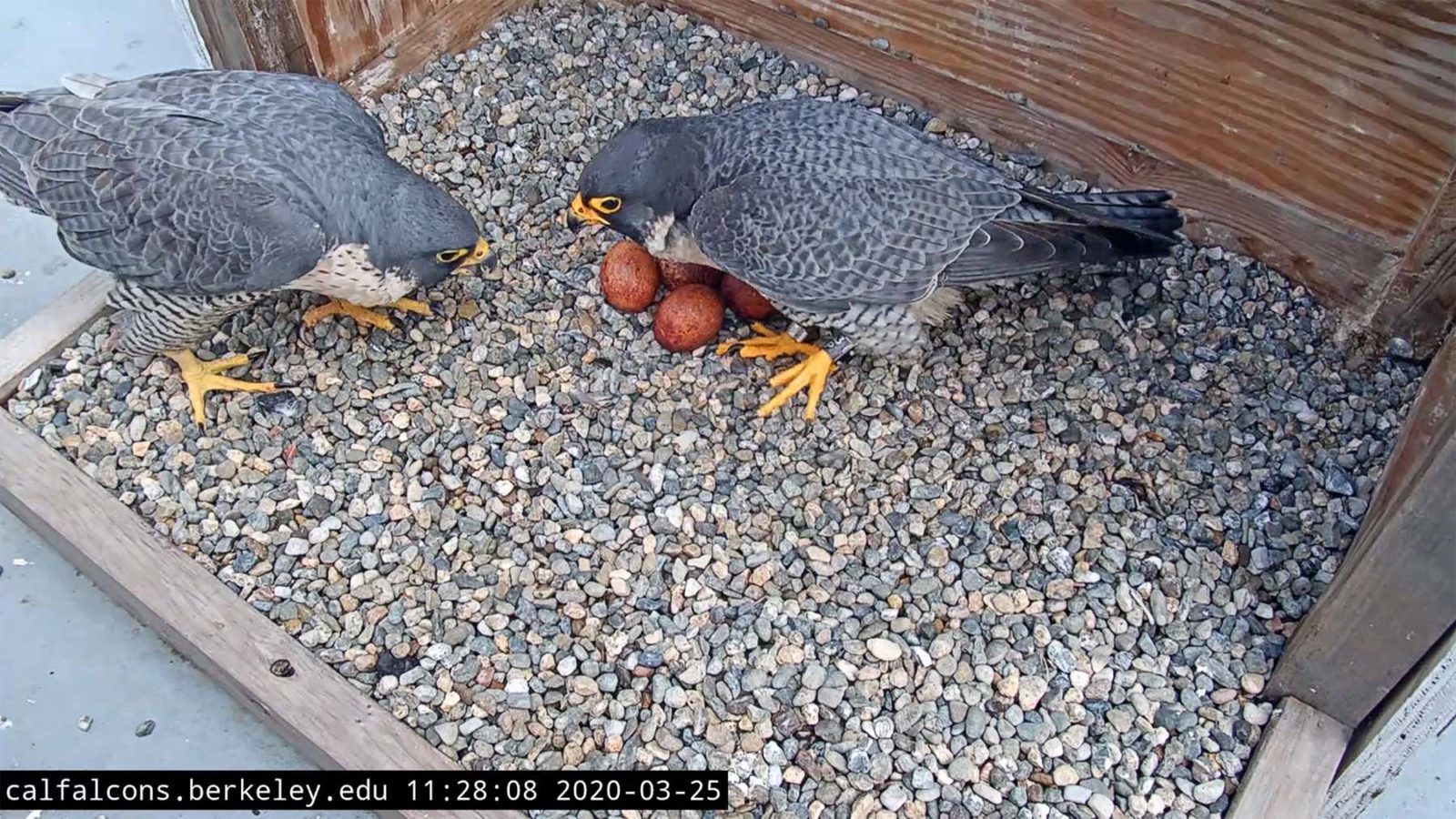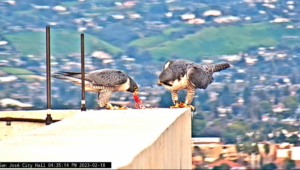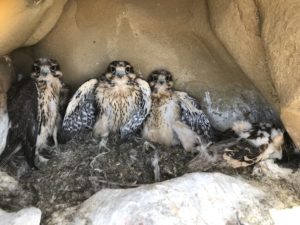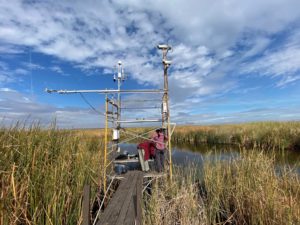In 2013, Colorado resident Holly Parsons suffered a traumatic brain injury while snowboarding that made it difficult for her to continue pursuing her outdoor interests.
Grappling with the permanent effects of her injury, Parsons turned to watching wildlife nest cameras as a means to connect with nature. Through nest cameras and online forums, she found a way to maintain a connection with the outdoors and socialize with other nature-lovers.
“It’s a real community and place to learn new things,” Parsons writes. “Somewhere to get away from the drama of the human world and share a common interest that is somehow more innocent and pure.”
In September 2019, Parsons founded a Facebook group for fans of a peregrine falcon nest in Orange, New South Wales after she came across the nest camera by chance and “fell in love with the falcon family there.” The group has since grown to include over 2,400 fans and has fostered worldwide connectivity over a shared love of falcons.
Members of the group share art and memes and celebrate falcons like Yurruga, a chick that hatched on Oct. 8, and Izzi, a fledgling from the previous season’s brood that lingered longer than his siblings at the nest site. Falcons have nested at the Orange site since 2008, and a total of 21 young falcons have successfully fledged.
Several months ago, an American member of Parson’s Orange Facebook group posted a link to UC Berkeley’s peregrine falcon nest camera, located at the top of the university’s Campanile clock tower. These Berkeley falcons were an opportunity for the Australian fan group to expand their falcon nest watching year-round.
Like UC Berkeley’s falcons, the Australian falcons’ nest is situated on a university campus, and the nesting season in Australia lasts from August through November while the Berkeley falcons nest during the Northern Hemisphere’s spring season. The Orange group quickly declared the Cal Falcons nest camera as its sister site because “having an off-season interest was perfect,” Parsons writes.
As live-streaming nest cameras have proliferated, the global public’s ability to tune into wildlife spectacles has greatly improved. And the Cal Falcons have become powerful and popular ambassadors for their species and their university worldwide, from Parsons’ sister group in Australia to fans in more than 40 countries.
UC Berkeley’s nest camera focuses on a pair of peregrine falcons named Annie and Grinnell that live at the top of the Campanile. The two have nested there since December 2016 and have raised 13 chicks from this site.
In the story’s latest dramatic turn, on Oct. 29 Grinnell was injured in a fight with two other peregrine falcons, a male and a female, that have since been seen perching on the Campanile. Grinnell was found later that day sitting on a trash can, wounded, and taken to recuperate at the Lindsay Wildlife Center in Walnut Creek.
According to the Cal Falcon social media updates, Grinnell’s beak tip was broken and he suffered wounds to his head, foot, and wing. Although Grinnell is currently gaining weight and is expected to make a full recovery and be released, it’s uncertain what happens next, and fans around the world are left to wonder — and keep watching.

Annie, Grinnell, and their chicks have drawn enormous public attention in large part thanks to the efforts of Lynn Schofield and Sean Peterson, the ornithologist couple that run the show behind the Cal Falcons’ presence, both on campus and online.
Remember, they are an exotic species in the Western United States, and are rapidly increasing their geographic range and range of habitats. Are they outcompeting or excluding native species in the process? How would we know? We have done almost nothing to monitor changes in the assemblage of mushroom species in areas before and and after the incursion of death caps.
Further Reading
Pringle et al, “The ectomycorrhizal fungus Amanita phalloides was introduced and is expanding its range on the west coast of North America,” Molecular Biology 2009
Lockhart et al, “Simultaneous emergence of multidrug-resistant Candida auris on 3 continents confirmed by whole-genome sequencing and epidemiological analyses,” Clinical Infectious Diseases 2017
Battalani et al, “Aflatoxin B1 contamination in maize in Europe increases due to climate change,” Scientific Reports 2016
The Cal Falcons will hold a live YouTube Q&A with a raptor expert about Grinnell’s recovery and peregrine falcon competition on Friday at 12 p.m. Learn more at calfalcons.berkeley.edu
Schofield and Peterson, along with a number of other local scientists and volunteers, monitor the Cal Falcons’ nest, manage media platforms, and host public events that allow community members to engage with the birds that have risen to near-celebrity status even beyond the wildlife watching community. In March 2021, during a nationally televised Cal basketball game, ESPN commentator Bill Walton took a moment away from basketball to mention the falcons nearby. “They’ve become an internet sensation,” Walton said.
Three live stream cameras, purchased after hundreds of crowd-sourced donations, also sit atop the Campanile, monitoring the falcon nest and Campanile perch. Since the cameras’ installation in 2019, the videos have amassed more than 2.4 million views on the Cal Falcons YouTube channel.
People watch the Cal Falcons — and others like them around the world — because peregrine falcons are relatable, personable, and cute, yet their lives are surprising and sometimes tragic. Peregrine falcon pairs like Annie and Grinnell tend to stick together for successive nesting seasons, but in Grinnell’s absence, the new male has been seen investigating the Campanile nesting box, and “ it appears that he is going to try to court Annie,” according to Cal Falcons updates. It is possible that Annie and the new male could nest together this coming spring.
At the same time, peregrines are known to display high nest site fidelity, even after being released after rehabilitation. So, depending on Grinnell’s recovery and release, he could also return to the Campanile.
Cal Falcons fans have voiced their shock and concern over Grinnell’s injuries, and “they are really pulling for him to get healthy and come back to pair with Annie,” Peterson writes. “If the new male becomes Annie’s new mate, hopefully people will recognize that it’s the natural progression typical of a wild peregrine nest, but it always is difficult when an animal you’ve spent years with either dies or loses the territory.”
At the moment, the future remains unclear. Either Annie and the new male will pair up — which is what often happens — or the new pair will displace both Annie and Grinnell, or Grinnell will return after being fully rehabilitated and deemed healthy enough to release, and he and Annie will reclaim their territory. But, for now, fans and experts alike can only watch and wait.
As Peterson writes, “competition for territories is increasingly common in the Bay Area,” and as upsetting and jarring as it can be for human audiences, frequent territorial disputes are a sign of peregrine falcon population success. It indicates that the species as a whole is well on its way to recovery.
The Cal Falcons have boosted this recovery each year since their establishment as new eggs are laid, chicks hatch, and tiny, downy-white nestlings quickly develop into the next generation of formidable fliers. The dramatic highs and lows of nesting season draw audiences in, with the live stream cameras offering viewers a window into the excitement and intrigue of one of the world’s most iconic raptor species.
In a contest to name the three most recent Cal Falcon chicks, fans from around the world suggested more than 650 names. The three winning names, Fauci, Kaknu, and Wek’-Wek’, received nearly one thousand votes each. (Facui was named after Dr. Anthony Fauci, the Director of the National Institute of Allergy and Infectious Diseases, and Kaknu and Wek’-Wek’ were named after falcon figures from the Ohlone and Miwok Indigenous cultures of the Bay Area.)
“It has definitely been this crazy, global thing that we were really surprised by,” Peterson said. “It’s been great to see how excited people have been, and it’s been fun to show our campus to people all over the world.”
“The initial appeal is what I call kittens and puppies,” said Tracy Maconachie, the project coordinator of the Manitoba Peregrine Falcon Recovery Project in Winnipeg, Canada. “It’s always hard not to fall in love with kittens and puppies, and it is hard not to fall in love with little peregrine falcon chicks. They can barely keep their heads up, and their parents so gently put food into their mouths. It’s hard not to get caught up in that — that’s our hardwiring, we’re watching their hardwiring, but that’s our hardwiring.”
Maconachie has spent 30 years monitoring peregrine falcons, banding chicks, and creating and contributing to the Manitoba Falcon Cam Forum, where she and other falcon fans keep tabs on nests around the world. Over the years, she grew to recognize and appreciate individual birds that would nest on the Radisson Hotel in downtown Winnipeg, her local peregrine nest site.
“We had a very successful female by the name of Princess,” Maconachie said. “When she disappeared and didn’t return in the spring, we went, well, that’s the way of it. Well, she turned up this year. She’s 19 years old — that’s old! It was wonderful seeing this bird again. She was a constant for 15 years. I have banded her chicks and banded her mates. Her grandkids are the ones that are all spread out over the U.S. Midwest. I’ve known this bird longer than I have known most of my current friends.”
Atsushi Toda, a Cal Falcons fan from Tokyo, echoed a similar sense of attachment to the chicks raised just above Berkeley’s campus.
“We like the scenes of chicks eating,” he writes. “It was a little bit visually shocking in the early days, but we are always impressed by how dedicatedly the parent falcons feed their chicks, which demonstrates their in-depth love.”
During nesting season, Toda and his wife would project the Cal Falcons live stream camera feed “almost 24/7” on their living room TV screen, watching as the chicks developed and grew.
“Peregrine chicks are polite to each other!” writes Parsons, founder of the Orange, Australia Falcon Facebook group. “Osprey chicks are not. With osprey, there is usually sibling rivalry for food, which can cause problems that aren’t fun to watch. But peregrines don’t have the same instincts. That opens the door for some very cute interactions between the peregrine chicks.”
This year’s chicks, after learning to fly, often engaged in games such as talon-tag and would pass food around in midair, engaging in play while also developing critical flight skills necessary for independent life.
“Peregrines are fun to watch in flight,” said Allen Fish, a biologist with the Golden Gate National Parks Conservancy and Cal Falcons collaborator. “They’re like the most incredible butterfly you can imagine. And the idea that those little tennis balls in that little box suddenly can become these incredibly dancey, energized, beautiful flying animals … the whole package is really amazing.”
“I watched kestrels, black storks, ospreys, and many American bald eagle sites,” writes Sandra Davies, a Melbourne-based fan of both the Cal Falcons and the Orange falcons, but “the peregrines remained my favorite to watch.” She describes how one of the falcon fledgelings at the Orange site named Izzi “is such a cute larrikin and has endeared himself to many.”
Megan Bernard and her young daughter watch the Cal Falcons from Sydney, Australia. They learned about them from Bernard’s sister, who moved from the UK to Berkeley. “What I loved about them was being able to watch them with minimal human interference and seeing how they care for the babies before and after they hatched,” Bernard writes. “I loved the way they stretched in the morning using their back legs, and funnily it reminded me of how my cats stretch when they wake up too.”
Even after the chicks grow out of their downy fluff and into their flight feathers, developing from a newly laid egg to fully fledged adult in roughly 80 days, the adult falcons, too, are captivating to global audiences. Still, Cal Falcons organizer Peterson said, there’s an extra bonus for people close to home: they get to see iconic birds living in (sometimes) iconic places.
“Peregrines have this mystique about them, being the fastest animal in the world,” Peterson said. “Being able to say ‘Hey, I know where that is, I can go see that bird, and it’s something that lives in a place that I have an emotional attachment to,’ is a major draw for people.”

In addition to the fluff and flying, the live-streamed video footage also captures the harrowing and sometimes tragic realities of the lives of wild animals.
“I think, for some people, [falcon camera watching] becomes a bit of an obsession in its own way, in the same way that some people get obsessed with birding,” said Stuart Harrington, co-founder of the London Peregrine Partnership. “But they’re not chasing rarities — they’re just so engrossed in the lives of their local peregrines. It’s like a real-life soap-opera. Every year there’s a new story. It’s very easy to get hooked on it. There’s always drama — there might be territorial disputes with intruding peregrines, or there might be drama with chicks that fall out of the nest.”
“It’s interesting and it’s also tragic sometimes, but that’s nature — it’s tough,” Harrington added. “I think that is also part of the appeal. What’s different between that and a soap opera is that it’s real, it’s all happening in real time … If everyone had a webcam on a robin’s nest in their garden, they’d probably get as invested in that, it’s just that not everybody has that, and it’s easy to go online and just find your local peregrine webcam.”
The highs and lows are a hallmark of these types of wildlife cameras, with the falcons’ tragedies and triumphs left raw and real for audiences to take in.
“We share the highs and the lows of the nest,” writes Parsons. “Sometimes chicks die and we cry together! And when a young peregrine flies from the nest for the first time, we cry then too!”
In 2017, Lux, a chick from Annie and Grinnell’s first Berkeley brood, died after colliding with a window at Evans Hall on the Berkeley campus. Afterward, Mary Malec and Doug Bell, two Cal Falcon collaborators, and Maria Garcia-Alvarez from UC Berkeley’s Facilities Management, added bird-deterring curtains to the windows at Evans Hall. Since these additions in July 2017, which covered windows in dark colored strips, no peregrines have hit Evans’s windows.
Windows pose a serious threat to modern day urban-nesting peregrines, said Schofield, a new threat to peregrine welfare that comes after decades of conservation action centered around the challenge of the insecticide DDT. The once-popular poison thins the eggs of birds, and led to population crashes in many large birds including falcons, eagles, and pelicans. By the time the state banned DDT from use, there were only two nesting peregrine falcons in California.
Then, reintroduction efforts “turned the peregrine faucet on,” GGNPC biologist Fish said. And these efforts helped to rebuild a species that was on the brink of extinction. Such historic conservation efforts and the role that humans have played in shaping the survival of peregrine falcons adds to their appeal to public audiences, Schofield said. Now, following the DDT ban and several decades of reintroduction work, there are around 400 nesting pairs, Fish said.
Among the 400 nesting pairs are Annie and Grinnell, boosting the Bay Area peregrine falcon population one brood at a time and generating public excitement in the process.
“It’s an annual tradition at this point,” said fourth-year UC Berkeley graduate student Leah Lee. “They come back, they lay eggs, we name them, they get banded, and then they fledge … the whole progression of birth and growth keeps me engaged.”
“Even if I graduate, even if I move away, I’ll definitely continue to check up on them. I’ll definitely still get the shirts and participate in the naming contests,” Lee said. “It’s a piece of Berkeley that will stay with me.”





